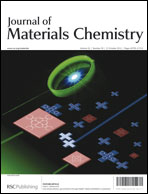A new method is developed in this work to fabricate large area poly(3-hexylthiophene) (P3HT) micro/nano-patterns. The method is based on solvent-infiltration imprint lithography (SIIL). P3HT micro/nano-patterns, including micro-prism arrays, nano-grating and nano-hole arrays, have been successfully prepared with features ranging from 400 nm to 3 μm. The regularity of the patterns was studied by SEM and the morphology of the pattern surfaces was investigated by atomic force microscope (AFM). The solidification mechanism of this method is based on solvent infiltration instead of external UV or heat to form the polymer pattern. This mechanism makes SIIL more universal, of lower cost than hard-mold imprint lithography, and more efficient than capillary force based lithography since high glass transition temperature (Tg) polymers or even polymer/nano-particle blends can be patterned quickly. Polymer solar cells with nano-hole arrays and nano-grating are prepared using SIIL, respectively, and the power conversion efficiency is improved compared with traditional film-structure polymer solar cells.

You have access to this article
 Please wait while we load your content...
Something went wrong. Try again?
Please wait while we load your content...
Something went wrong. Try again?


 Please wait while we load your content...
Please wait while we load your content...